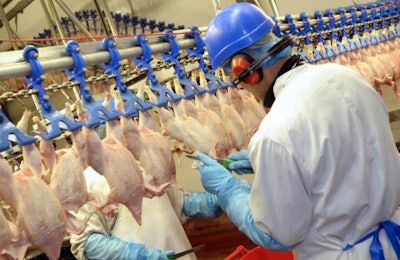
It is no great surprise to hear that yet another poultry processing plant or other food producing facility has conducted a deep clean. Thanks to COVID-19, we all have hygiene on our minds and disinfectant gel on our hands. But just how effective are sanitation measures, even when properly applied?
A team of researchers, albeit working prior to the emergence of the novel coronavirus, sought to answer this very question where processing plants are concerned and specifically regarding Salmonella enterica survival. Their findings, even where companies were strictly adhering to the rules, were less than encouraging.
According to the Mississippi State University study published in Poultry Science, the prevalence of Salmonella on processing equipment following cleaning and sanitation, and its potential risk for food safety, had never previously been thoroughly evaluated. To remedy this, from January 2018 to January 2019, they conducted a study to evaluate how much Salmonella survived, if any, on processing equipment after cleaning and sanitation.
The research team looked at 15 specific locations within six commercial processing plants, with each sampled at three time points: Point A, immediately following processing, point B after cleaning, and point C after sanitation. Over three visits, 135 samples were taken.
When and where
Salmonella-positive isolates were recovered from samples using the U.S. Department of Agriculture MLG 4.09 conventional method.
Unsurprisingly, there was a difference in the recovery of Salmonella depending the sampling time. At time point A it was 35%, whereas at point B it was 12% and at C 9%.
Different locations within the plants also recorded different prevalence. For example, the head puller, picker, cropper and scalder had significantly higher prevalence than other locations, particularly when compared with secondary processing equipment.
Salmonella was recovered from all of the plants sampled, and factors contributing to its presence may have included choice of antimicrobial, cleaning procedures followed, and the attachment of Salmonella in biofilms. Some plants recorded lower prevalence than others, and only one recorded no Salmonella post-sanitation.
The researchers stress that the plants visited dedicated substantial time to the cleaning and sanitation of equipment and their facilities between the end of one shift and the start of the next, however, they add that more effort may be needed to completely address Salmonella contamination.
They also add that having data on the prevalence of Salmonella in the flocks being processed would have aided their studies, as would information on Salmonella prevalence on the processed birds at retail level. Nevertheless, they argue that their study helps to fill some gaps in what is known about efficiency of cleaning and sanitation to reduce Salmonella contamination.
With the current greater emphasis on hygiene, the survival of Salmonella in processing plants may have been further reduced, but the study nevertheless offers insight for the design of new sanitation protocols when, and if, things do eventually return to normal and the novel coronavirus is behind us.
















